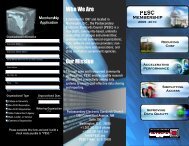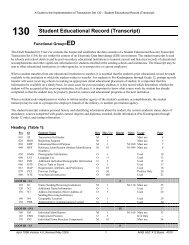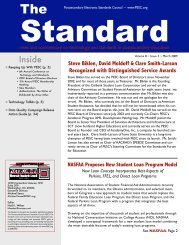February 2013 - PESC
February 2013 - PESC
February 2013 - PESC
You also want an ePaper? Increase the reach of your titles
YUMPU automatically turns print PDFs into web optimized ePapers that Google loves.
16<br />
Do you outsource e-mail for faculty and staff and if so,<br />
to whom?<br />
Don’t outsource<br />
Google<br />
Microsoft<br />
Other<br />
Which best describes your plans for desktop<br />
virtualization?<br />
Used to replace student labs<br />
67.7%<br />
18.8%<br />
9.9%<br />
3.6%<br />
Used as a thin-client solution for staff/faculty<br />
23.5%<br />
Used as a “bring your own” device solution<br />
Used to support distance education students<br />
13.3% 3.6%<br />
Used mostly by students<br />
Used as a security strategy<br />
24.7%<br />
16.7%<br />
11.2%<br />
10.6%<br />
considering or using VDI as a solution for students. For<br />
both students and faculty/staff uses, institutions cited<br />
replacing student labs (25%) and using it as a thin client<br />
for faculty and staff (24%) as the top two reasons for<br />
VDI. In terms of the goal for VDI, approximately 17% of<br />
the respondents indicated support for BYOD strategies,<br />
and 13% of the reasons cited were to support distance<br />
education for students. About 10% of respondents cited<br />
security as the goal for VDI. VMWare is the VDI tool<br />
deployed by 49% of the respondents, while Citrix was<br />
listed by 29%, Microsoft by 9%, Xen by 3%, and a variety<br />
of others by 11%.<br />
With the broad adoption for VDI, it is helpful to look at<br />
what our respondents said about the future of desktop<br />
installations and community labs. As expected, these<br />
two areas are seeing slower growth. Just 50% of the<br />
institutions expect desktop installations to stay about<br />
the same or decrease. Forty-seven percent expect<br />
desktop installations to grow. Community labs are much<br />
more likely to shrink in the coming years. Only 15% of<br />
the institutions expect community labs to grow, with 85%<br />
seeing a decrease or no growth. A sizeable number of<br />
institutions (37%) expect student use of WiFi and local<br />
area network ports to augment the use of community<br />
labs, thus curtailing any growth.<br />
Institutions would like to decrease the number of<br />
community labs being supported, but about as many are<br />
increasing their number of community labs (15.2%) as<br />
are decreasing their number of supported labs (17.4).<br />
However, VDI and BYOD may have a greater effect on<br />
those numbers in the future.<br />
Infrastructure<br />
and Networking<br />
Infrastructure in the Perfect Storm<br />
Buzzwords and topics like “cloud storage,” “BYOD,” and<br />
“security breach” have caught the attention of CIOs<br />
in the industry. Do these concepts have any particular<br />
implications for infrastructure and networking on<br />
university campuses? The LBCIO survey focused on<br />
three primary areas that might be affected by current<br />
technology trends:<br />
• Security<br />
• Disaster recovery and business continuity<br />
• Networking infrastructure
















